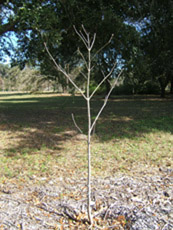Aesculus pavia (Red Buckeye)

*Click on picture for more images of this species.
- USDA Hardiness Zone: 6A - 9A
- Mature Height: 15 to 20 ft
- Mature Spread: 15 to 25 ft
- Growth Rate: Moderate
- Availability: Somewhat available
- Drought Tolerance: Moderate
- Salt Tolerance: Moderate
- Light Requirements: Partial sun to partial shade.
- Soil Drainage: Tolerates well-drained sites to sites with extended flooding.
- Native Origin: Native to Florida.
- Foliage: Deciduous tree with no showy fall color.
- Flowers: Red, showy, non-fragrant flowers in the spring.
- Pests: Free of serious pests and diseases.
Description: Red Buckeye is a small, understory, North American native tree, capable of reaching 25 to 30 feet tall in the wild though is most often at 15 to 20 feet high when grown in cultivation. Red Buckeye is most popular for its late winter display of three to six-inch-long, upright, terminal panicles composed of 1.5-inch-wide, red flowers which are quite attractive to hummingbirds. These blooms are followed by flat, round capsules which contain bitter and poisonous seeds. The large, dark green, palmate leaves usually offer no great color change in fall and often drop as early as late September.
The coarse, open structure and the light brown, flaky bark is quite attractive and offers great winter landscape interest. Branches arise from the typically straight trunk at a wide angle forming a durable structure. There are many, small-diameter branches with an occasional upright, aggressive one growing as large as the trunk. Main branches begin forming low on the trunk and remain there when grown in the full sun. The tree is best used as a novelty patio tree or as part of a shrubbery border to add bright red color for several weeks in the spring and coarse texture during the rest of the year. Plant it in a medium- to large-sized residential landscape as a very coarse accent. Extremely coarse in winter without leaves, Red Buckeye will attract attention with the bright brown or tan bark reflecting the rays of the sun.
Lower branches can be removed to allow for clearance beneath the crown, but the tree looks its best planted in the open to allow branches to fully develop to the ground. Red Buckeye will flower well in rather dense shade but takes on a denser form when grown in more sun on moist, well-drained soil. It is native along moist stream banks and is not very drought-tolerant.
Gainesville Observations: Trees are growing very slowly and appear dead in winter due to early deciduous habit in fall. The wonderful deep red flowers appeared in mid-February followed by the bright medium green palmately compound foliage. Foliage dries and turns brown around the edges by mid summer, even in our mulched and irrigated plots. I wonder if this will be suited for planting along streets due to its susceptibility to dry soil. Once the tree gains some size (currently trees are 5 feet tall) flowers should present quite a show for a week each year.
Fact Sheet (pdf)
Click here for more photos of this tree.

